E.G. Lewis's Blog, page 8
March 2, 2012
BURIAL PRACTICES OF THE EARLY CHRISTIANS
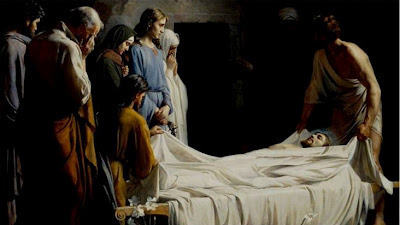
Hello My Friend and Welcome.
Today, in anticipation of Good Friday and the burial of Our Lord, we examine some of the burial rites and traditions of 1st Century Jews and the early Christians. Because of Christianity's Jewish roots, let's first make a short review of Jewish traditions concerning the dead. You'll find the parallels with Christian practices enlightening.
Judaism, like Christianity, is based on traditions and rituals. Ritualized mourning serves several purposes, it shows respect for the dead, comforts those left behind, helps prevent excessive mourning, and eventually leads the bereaved back to normal life.
A MEAL OF CONDOLENCEThe tradition of the se'udat habra'ah — a meal of condolence seems to be an exclusively Jewish one. There are deep psychological reasons behind this gesture. It recognizes that mourners, having just returned from the heavy trauma of the burial, may harbor a death wish for themselves and not want to go on without their loved one. The meal they must eat speaks to that part of them saying, "No, you must go on. You must affirm life and live." The meal consists of Bread, considered the sustenance of life, Hard Boiled Eggs, a round food representing the cycle of life, and Lentils, which are also round.
JEWISH MOURINING PRACTICESThe first (intense) period of mourning, Shiva (seven), lasts seven days. Mourners sit on low stools or the floor instead of chairs…hence, the term Sitting Shiva. The next period, known as Schloshim (thirty), lasts until the 30th day after burial. The final period of formal mourning, Avelut, lasts for 12 months from burial and is observed only for a parent. After the first year, the anniversary of death (yahrzeit) is remembered annually.
EARLY CHRISTIAN MEMORIALSIn the early Christian communities the third, seventh, and thirtieth day were memorial days, on which there was a ceremony for the dead. There was also a memorial service on the anniversary of a person's death and each year thereafter. The date of a saint's death was considered their "Birthday" into eternal life and was thus celebrated annually. A saint's day of memorial on the liturgical calendar has always been on the day of their death, not their birth as it is with our modern custom with Washington's birthday, Lincoln's birthday, Martin Luther King's birthday, etc. The third day memorial is clearly a reference to the Resurrection; however, interestingly enough, there is a modern trend in some parts of Judaism to reduce the period of Shiva to three days.
GRECO-ROMAN HANDLING OF THE DEADThe Romans, Greeks as well as most other ancient cultures practiced cremation. The Jews, however, considered burial the only proper method of disposing of a dead body. Even God himself is depicted in the Torah as performing a burial: "And God buried him (Moses) in the depression in the land of Moab, opposite Beth Peor. No man knows the place that he was buried, even to this day." (Deuteronomy 34:6).
In the light of the belief in the resurrection of the body in Jewish tradition (Tobit 1:21; 12:12; Sirach 38:16; 2 Maccabees 12:39) as well as in Christianity, it is easy to understand why the interment of the mortal remains of the Christian dead has always been regarded as an act of religious importance and has been surrounded with some measure of ceremony.
A CHRISTIAN BURIALIt is clear that from the very beginning the early Christians buried their dead. This conclusion is supported by direct testimony from ancient documents such as The Octavius by Minucius Felix, Tertullian's De Corona as well as from the stress laid upon the analogy between the General Resurrection of all faithful and the Resurrection of Christ (1 Corinthians 15:42, Tertullian's De Animâ and Augustine's City of God).

Later, when the Christians in Rome began to place their dead in the catacombs, they developed their own language in speaking about death. They referred to the catacombs as Koimeteria, dormitories. For a pagan, a dormitory was the room where you went to bed at night and rose in the morning. For Christians it meant more than that. You went to sleep so that you might waken again. Thus death was but a place of rest from which you would certainly rise anew.
A second example is the word Depositio. Markers with the word Depositus, (abbreviated depo, Dep or simply D) can immediately be identified as Christian. Depositio was a legal term used by lawyers, which meant giving on deposit. To the early Christians, the dead were deposited in the earth like grains of wheat to be restored in the future crops.
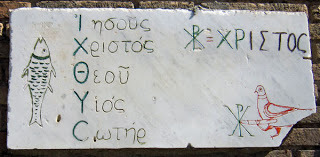 Inscriptions and Symbols on a Marble SlabEach side of the catacomb had rows of rectangular niches, called loculi, cut into the walls. They typically contained only one body, occasionally two…perhaps in the case of a husband and wife who died together. The burials of the early Christians were simple affairS. The corpses, in imitation of Christ, were wrapped in a sheet or shroud and placed in the loculi without any kind of coffin. The loculi were closed with a slab of marble or, in most cases, clay tiles fixed by mortar. The name of the deceased was painted or engraved, along with a Christian symbol or a wish that the person find peace in heaven. Oil lamps and small vases containing perfumes were often placed beside the tombs.
Inscriptions and Symbols on a Marble SlabEach side of the catacomb had rows of rectangular niches, called loculi, cut into the walls. They typically contained only one body, occasionally two…perhaps in the case of a husband and wife who died together. The burials of the early Christians were simple affairS. The corpses, in imitation of Christ, were wrapped in a sheet or shroud and placed in the loculi without any kind of coffin. The loculi were closed with a slab of marble or, in most cases, clay tiles fixed by mortar. The name of the deceased was painted or engraved, along with a Christian symbol or a wish that the person find peace in heaven. Oil lamps and small vases containing perfumes were often placed beside the tombs. Next time we'll see what we can learn from the 1890 painting The Three Mary's at the Empty Tomb by William Adolphe Bouguereau.
Until then, we wish you Peace and Blessings.
If you reached this post via a link, click the HOME tab above to see other recent posts and visit our archives.
Published on March 02, 2012 01:00
February 29, 2012
HOW THE DATE OF EASTER IS DETERMINED
 The Paschal Full Moon Determines the Date of Easter
The Paschal Full Moon Determines the Date of EasterHello My Friend and Welcome. We continue our Lenten — Easter Series with a discussion of how the date of Easter is determined. I recall, as a child, overhearing adults say, "Isn't Easter early this year?" or "Easter sure is late this year." I found this very confusing. What did they mean late or early? Easter came the same time as any other year…on Sunday. Easter is, and always has been, a movable Feast. In many parts of the world Easter is known as the Pascha, from the Greek word for Pesach, or Passover. As we know from the Bible, Jesus was arrested and executed on a Friday during the Jewish Passover week. And, as we also know, Easter is a celebration of his Resurrection on the following Sunday. So, in my defense, I was partially right. It always comes on Sunday…at least it does now.
EASTER, PASSOVER AND THE QUARTODECIMAN CONTROVERSYLike our Easter, Passover is a movable, seven-day Feast which begins Nisan 15 (at sundown Nisan 14) and is determined by the phases of the moon. The Early Church was comprised mostly of Jews and so they continued to follow the Hebrew calendar and celebrated the day of Resurrection following Passover. However, since Passover can fall on any day of the week, this meant that the Resurrection was not always celebrated on a Sunday. And that's when things started getting sticky.
The result was what has come to be called the "Quartodeciman Controversy," from the Latin quatro decima or fourteen. The Controversy boils down to a simple question: Must the Resurrection be celebrated on a Sunday? The writings of the Church Father, Irenaeus, state that Polycarp, Bishop of Smyrna, kept the Feast on the fourteenth day of the moon, whatever day of the week that might happen to be. In other words, he celebrated the Resurrection on the day of Crucifixion. Keep in mind that, like Ignatius of Antioch, Polycarp was a disciple of the Apostle John, and he claimed the tradition came from St. John himself. Meanwhile, the Roman and Alexandrian churches began extending the Lenten fast until the Saturday after the 14th and celebrated the Resurrection the following day, on Sunday. Though argued and debated, the issue was never conclusively resolved.
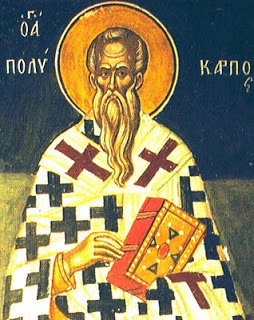 Polycarp, Bishop of Smyrna
Polycarp, Bishop of SmyrnaRELYING UPON THE HEBREW CALENDARWe find both practices continuing as we move forward in time. But, regardless of whether you celebrated the Day of Resurrection or the Sunday of Unleavened Bread, you were still dependent upon the Jewish calendar to establish the date of Nisan 14. By the later 3rd century the Church had become thoroughly gentile and some Christians expressed dissatisfaction with the custom of relying on the Jewish community to determine the date of a Christian Feast. They also complained that the observance of a full moon varied between the northern and southern hemispheres, leading to errors.
Anatolius of Laodicea in the later 3rd century wrote, "Those who place the first lunar month of the year in the twelfth zodiacal sign before the spring equinox and fix the Paschal fourteenth day accordingly, make a great and indeed an extraordinary mistake." An ancient paschal table confirms these complaints, indicating that Jews in some eastern Mediterranean city (possibly Antioch) fixed Nisan 14 on March 11 in AD 328, on March 5 in AD 334, on March 2 in AD 337, and on March 10 in AD 339, all well before the spring equinox. This led some Christians to experiment with their own computations. However, others advised, "Do not do your own computations, but instead observe Passover when your brethren from the circumcision do. If they err, it is no matter to you...."
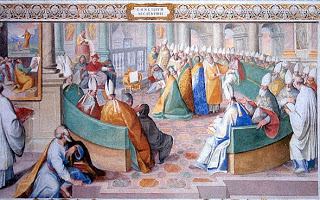 Painting of the Council of Nicea
Painting of the Council of NiceaTHE COUNCIL OF NICAEA TACKLES THE ISSUEConstantine addressed the issue when he convened the Council of Nicaea and severed any remaining tie between Christianity and Judaism when he wrote, "It appeared an unworthy thing that in the celebration of this most holy feast we should follow the practice of the Jews...For we have it in our power, if we abandon their custom, to prolong the due observance of this ordinance to future ages by a truer order...For their boast is absurd indeed, that it is not in our power without instruction from them to observe these things....Being altogether ignorant of the true adjustment of this question, they sometimes celebrate Passover twice in the same year." As a result, the First Council of Nicaea in 325 endorsed the idea of independent calculations and set the date of Easter as the Sunday following the paschal full moon, which is the full moon that falls on or after the vernal (spring) equinox.
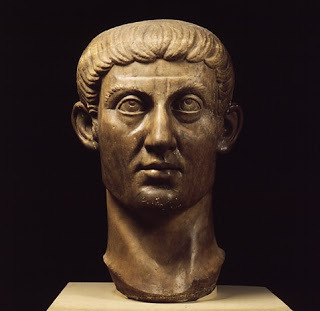 Constatine the Great
Constatine the GreatA TALE OF TWO CALENDARSThe Church does not use the exact date of the paschal full moon but an approximation, because the paschal full moon can fall on different days in different time zones, which raises the old problem of having more than one date for Easter. For purposes of calculating the date of Easter, the full moon is assumed to be the 14th day of the lunar month. The Church also set the date of the vernal equinox as March 21, even though it sometimes occurs on March 20. Using these approximations allowed the Church to set a universal date for Easter. If only it were that simple.
The world of Constantine ran on the Julian calendar. Introduced by Julius Caesar in 45 BC as a reform of the Roman calendar, it was developed with the help of astronomer Sosigenes of Alexandria. It contained 365 days a year and allowed for a leap year every fourth year. As accurate as it was, the Julian calendar was still off by 11 minutes a year. This tiny error caused it to gain three days every four centuries. The Gregorian calendar, introduced in 1582 and still in use today, eliminated this problem.
But by that time the Church had split into an Eastern, or Orthodox, branch and a Western, or Roman, branch. The Western Church calculates Easter using the Gregorian calendar. Our Eastern brothers, however, seeking to celebrate the traditional date of the Pascha, continue to adhere to the older Julian calendar. Because of the Julian calendar's continual slippage, March 21 on the Julian calendar corresponds to April 3 on the Gregorian calendar.
Easter can come no earlier than March 22nd. and no later than April 25th. However, by the following the Julian calendar, the Orthodox celebration of Pascha can fall between April 4 and May 8. Some Orthodox communities have begun using a revised Julian calendar for their calculations and others retain the older ways.
Since the full moon is at the root of both calculations, the date of Easter/Pascha depends upon which moon is chosen. In those years when both branches of the Church use the same moon, the date of the Feast is the same. When the Eastern Church uses a later moon, there can be an extreme variance. For instance, both branches celebrated Easter on April 24th in 2011. The date in 2012 for the Western Church is April 8th while for the Eastern Church it will be April 15th. For 2013, the dates are March 31st in the West and May 5th in the East. In 2014, the dates again converge on April 20th.
With an eye toward the crucifixion and burial of Jesus on Good Friday, next time we'll look at ancient burial practices.
Until then, we wish you Peace and Blessings.
If you reached this post via a link, click the HOME tab above to see other recent posts and visit our archives.
Published on February 29, 2012 01:00
February 27, 2012
LENT & EASTER - PRETZELS
 Hot, Salty Prestzels...Is There Anything Better?
Hot, Salty Prestzels...Is There Anything Better?Hello My Friend and Welcome.
Today our Lenten & Easter Series continues with a look at a special Lenten food, pretzels. Nowadays, pretzels are eaten as a snack food, which, in a way, was how they started out. The pretzel has its origins as an official food of Lent. Interestingly enough, the Vatican Library has a manuscript dating to 5th Century with the earliest known illustration and description of what we commonly call the pretzel.
To put the pretzel in perspective, we must first remember that in the early Church, the Lenten abstinence and fasting laws were much stricter in the Early Church than what we practice today. As we saw in our Shrove Tuesday post, believers avoided all animal products during Lent. This meant no milk, no butter, no cheese, no eggs, no cream and no meat. The fast consisted of a single meal eaten in the late afternoon or evening. Small snacks were permitted during the day to allow a person to keep up their strength. This, of course, led to a search for simple foods that fulfilled the fasting laws.
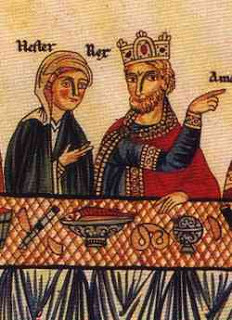 Earliest Depiction of PretzelsINVENTING THE PRETZELIt became a common practice for people to prepare a special, unleavened bread made from water, flour and salt during Lent. The story goes that one day a monk in the monastery's bakery decided to remind the other monks that Lent was a time of prayer. He did this by forming the dough into thin strips and shaping them in the form of crossed arms. At that time people commonly folded their arms over each other on the chest.
Earliest Depiction of PretzelsINVENTING THE PRETZELIt became a common practice for people to prepare a special, unleavened bread made from water, flour and salt during Lent. The story goes that one day a monk in the monastery's bakery decided to remind the other monks that Lent was a time of prayer. He did this by forming the dough into thin strips and shaping them in the form of crossed arms. At that time people commonly folded their arms over each other on the chest.  How You Make a PretzelInitially the Lenten bread was baked as a soft bread, just like the big soft pretzels we still find today. Whether or not they put rock sale on them, no one knows. Because of their shape, these breads were called bracellae, a Latin term meaning "little arms." The Germans derived the word bretzel from it and, when they came to America, they became pretzels.
How You Make a PretzelInitially the Lenten bread was baked as a soft bread, just like the big soft pretzels we still find today. Whether or not they put rock sale on them, no one knows. Because of their shape, these breads were called bracellae, a Latin term meaning "little arms." The Germans derived the word bretzel from it and, when they came to America, they became pretzels. Another source suggests that the origin of the word pretzel comes from a habit the monks had of giving these breads to children as a reward when they could recite their prayers. The Latin word for "little reward" is pretiola. A bit of a stretch, but one never knows.

This simple Lenten food quickly grew in popularity. Pretzels were considered a symbol of good luck, long life and prosperity. Interestingly, they were also a common food given to the poor and hungry. Not only were pretzels easy to give to someone in need, but they were substantial enough to satisfy a person's hunger. They also served as a reminder that God knew a person's needs and answered their prayers.
SLEEPING ON THE JOBSo how did these soft bracella, pretiola, bretzel/ pretzels became the crisp, crunchy snack we've grown accustomed to? Ah, there's a story for that as well. We're told that a young apprentice baker dozed off while tending the oven while the pretzels were baking. The oven fire began to die out, and, when he awoke, he noticed and immediately stoked the oven. The result was that he over-baked the pretzels. At first the master baker was upset, but when he discovered how good the hard pretzels were he relented.
Hard pretzels, of course, are less perishable than the soft variety and make it easy to keep something on hand to give to the poor and hungry when they knocked at the door. By the way, if the only kind of hard pretzel you've ever had is the thin ones, you might check at the grocery to see if they have the Snyder's of Hanover Pennsylvania brand. They still makes the traditional hard, fat pretzels.

Another bit of pretzel lore dates back to the late 1500s. It seems the Ottoman Moslem Turks were besieging the city of Vienna, Austria. However, the Turks were unable to break the city's defenses and decided to tunnel in. There were some monks —can't have pretzel stories without those monks— who were in the basement of the monastery baking pretzels. They heard the sound of digging, alerted the authorities, and the city was saved.
A near as we can tell there is no story that explains the connection between beer and pretzels. One can only assume that the Germans just happened to like some bretzels with their lagers.
We all know that Easter is a variable feast. Unlike Christmas, it doesn't come on the same date every year. Next time, our series continues with a study of how and why they determinded a method for establishing the date of Easter.
Until then, we wish you Peace and Blessings.
If you reached this post via a link, click the HOME tab above to see other posts and our archives.
Published on February 27, 2012 01:00
February 24, 2012
LENT & EASTER - FASTING
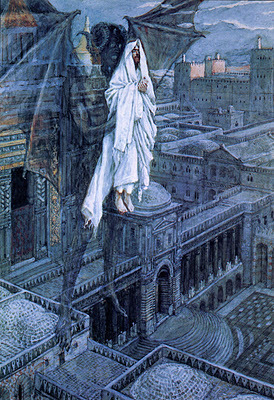 Temptation of Christ by TissotHello My Friend and Welcome.
Temptation of Christ by TissotHello My Friend and Welcome. "Then Jesus was led up by the Spirit into the wilderness to be tempted by the devil. And he fasted forty days and forty nights, and afterward he was hungry. And the tempter came and said to him, 'If you are the Son of God, command these stones to become loaves of bread.' But he answered, 'It is written, Man shall not live by bread alone, but by every word that proceeds from the mouth of God.'" —Matthew 4:1-4
Today we continue our series of Lenten/Easter posts with a look at fasting. Think of Lent and most people immediately think of fasting. But what is fasting, and what is not fasting? Why do we fast? Does God expect us to fast? What do we gain by it?
In our original post in this series, Quinquagesima Sunday, we detailed some of frequent occurrences, and importance of, the number forty throughout the Bible. As ubiquitous as forty seems to be, fasting occurs at least as often.

WHAT IS, AND WHAT IS NOT, FASTINGFirst, and foremost, fasting is a sacramental; a holy practice through which we are drawn closer to God. In its truest form, fasting is very simple. We do not eat. Period. Now we all know that the human body requires sustenance. Going without food for an extended period of time can have serious consequences. How long a person can survive without food depends on body size, metabolic rates, surrounding conditions, and lots of other factors. Needless to say, starving to death is a very unpleasant experience. While it takes a relatively long time to starve to death, a person dies in only 3-5 days without water. The message here is that when undertaking a holy fast, a person must still drink water and eat something.
If you will permit me a little aside here, I'd like to address a misconception that I've heard from a number of Christians. Some people tell me when Jesus fasted in the desert for forty days and nights he didn't eat or drink anything. One woman said, "I could never do that, but after all, he is God." The point she's missing is that he was also man, and as a man he needed food and water just as we do. I've heard radio preachers say things like, "He went into the desert where there was no food or water."
 Jesus in the WildernessCome on folks, let's use our heads here. Reread the quote from Matthew at the top of this post. Jesus went into the wilderness. Funny that people imagine Jesus couldn't find food, but they readily accept that John the Baptist survived in the wilderness on "locusts and wild honey." (By the way, the practice of eating locusts continues to this day.) In the wilderness there also things such as pine nuts, wild berries, etc. Matthew adds, "…and afterward he was hungry." Of course he was; he'd been fasting. Fasting, not starving.
Jesus in the WildernessCome on folks, let's use our heads here. Reread the quote from Matthew at the top of this post. Jesus went into the wilderness. Funny that people imagine Jesus couldn't find food, but they readily accept that John the Baptist survived in the wilderness on "locusts and wild honey." (By the way, the practice of eating locusts continues to this day.) In the wilderness there also things such as pine nuts, wild berries, etc. Matthew adds, "…and afterward he was hungry." Of course he was; he'd been fasting. Fasting, not starving. WHY A PERSON FASTSDespite being made in the image of God, we remain physical creatures. Our response to sacred moments must involve not just our mind, but our body as well. This is why the Church calendar contains both feasts and fasts. St. Augustine deals with the idea of fasting in this way, "We must fast because it is sometimes necessary to check the delight of the flesh in respect to licit pleasures in order to keep it from yielding to illicit joys."

A number of Early Church Fathers recommend fasting as a way to build discipline. Our modern world rejects the idea. We live in a society that glorifies consumption. Party hardy…eat, drink and be merry. So let's look at some other ways to view fasting. Think of it as a way to physically express our hunger for God in our life. As John Calvin said, "…with a full stomach our mind is not so lifted up to God."
A person can use a period of fasting to become one with those who suffer from food depravation. When you feel a hunger pang, imagine what it must be like to see your children starving and have no way of providing the food that they need. Food always tastes better when we're hungry. If you want to be hungry, fast. And then when you do eat, eat with a deep appreciation for the food that God has provided you. Make the practice of eating a prayer of thanksgiving.
MODERN FASTINGAs we learned in our Shrove Tuesday Post, in times past Lent was a time of real, self-imposed hardship. Christians did without all animal products…fats, meats, milk and eggs. There are many instances in history where people ate nothing during the day and ended the fast with a single evening meal. In the Early Church the believers maintained a vigil fast from Good Friday afternoon —the time of Jesus' death— until Easter morning. If you count it out, you'll see it comes to 40 hours, the time Christ is traditionally assumed to have been in the grave.
The modern Lenten fast usually entails abstaining from meat on Ash Wednesday and Fridays, eating only one full meal a day, making the other two combined less than a full meal, and not eating between meals. So, rather than fasting, most people today abstain. That is, they do without certain foods during specific periods. This is where the phrase, "What are you giving up for Lent?" comes from. In addition to the regimen above, or in some cases instead of, people decide to give up one item or food group that they particularly enjoy. Most commonly it is sweets.
NOT AN OPTIONAL PRACTICEOne thing that must be understood about fasting is, except for the elderly or infirm, fasting is a requirement of Christian life, not an optional practice. Both the Old Testament and the New make it clear that believers are expected to fast. How you do it, when you do it, and why you do it are up to you. But the bottom line is you are expected to fast. Jesus said, "The time will come when the bridegroom will be taken from them; then they will fast." (Matt. 9:15) Recall also that Acts tells us that, "…while they were praying and fasting the Holy Spirit came upon them."
Our next post in this series will continue the idea of fasting by examining a particular food developed specifically for Lenten fasting.
Until then, we wish you Peace and Blessings.
If you reached this post via a link, click the HOME tab above to see other posts and our archives.
Published on February 24, 2012 01:00
February 22, 2012
LENT & EASTER - ASH WEDNESDAY
 The Imposition of Ashes is an Ancient Tradition
The Imposition of Ashes is an Ancient TraditionHello My Friend and Welcome.
Our Lenten-Easter series continues. Today, as many of you know, is Ash Wednesday, a day when many people have ashes placed on their forehead in the shape of a cross while the one administering them says the words from Genesis 3:19 "Remember man, you are dust, and to dust you shall return."
THE SANCTIFICATION OF THE EVERYDAYOne the beliefs that Christians took with them from Judaism is the idea that everyday things can be sanctified when their use is dedicated to God. The most obvious example would be the bread and wine of the Eucharist. But water is sanctified through Baptism and oil through the sacrament of Anointing. Like other pious devotions, the imposition of ashes is what might be called a sacramental. That is, a practice which affirms a person's beliefs and, in so doing, deepens their faith. Early Christians believed these practices to be a source of grace and many continue those traditions today.
DIES CINERUM – THE DAY OF ASHESThe earliest references of Ash Wednesday date to the Fourth Century and refer to it as dies cinerum, day of ashes. On this day all the faithful according to ancient custom approached the altar where the priest dipped his thumb into blessed ashes and made the sign of the cross on their forehead. The ashes used in this ceremony are made by burning the remains of the palms blessed on the Palm Sunday of the previous year.
 A Soldier Receives Ashes
A Soldier Receives AshesThe custom of distributing ashes to all the faithful arose from a devotional imitation of the practice observed in the case of public penitents. In Biblical times men who repented of their sins covered themselves with ashes and clothed their bodies with sackcloth. By participation in this ceremony a believer was symbolically making a public confession of their own sinfulness and asking for forgiveness. The person is also forcefully reminded of their own mortality and, with it, impending judgment.
SIN AND PUBLIC REPENTANCEIn the Early Church, Ash Wednesday was the day on which those who had sinned, and wished to be readmitted to the Church, would begin their public penance. It must have been a powerful reminder for those leaving the Church to see the penitent wearing the same ashes they wore on their foreheads.
In its earliest form Lent was the final preparatory stage before Baptism, which took place on Holy Saturday night…after sundown and therefore on Easter Sunday under the Jewish system of calculating days. Ashes as a symbol of repentance appear throughout the Old Testament. Jesus mentions ashes in Matthew 11:21 and Luke 10:13, "Woe to you, Chora'zin! woe to you, Bethsa'ida! for if the mighty works done in you had been done in Tyre and Sidon, they would have repented long ago, sitting in sackcloth and ashes." The use and meaning here was to provide an outward or ritual expression for the repentance of sin just as is done today on Ash Wednesday.
EARLY CHURCH FATHERS ON THE PRACTICE OF ASHESThis thought carried over into the Early Church. The theologian, Tertullian, described the use of sackcloth and ashes in the penance of an adulterer. And later Church Fathers Eusebius, Cyprian, and Jerome also associated ashes with public repentance. The last of the early fathers, Isidore of Seville (560-636), described the practice of his day with these words, "It is good, therefore, that a penitent deplore his sin in sackcloth and ashes, for in sackcloth is harshness and the prick of sin; and the ashes, moreover, display the dust of death."
 A Workmen Prays after Receiving Ashes
A Workmen Prays after Receiving AshesMany Protestant churches also offer a ritual imposition of ashes on Ash Wednesday. Interestingly, the Eastern, or Orthodox, Church still uses the Julian calendar to calculate the date for Easter. This necessitates a change in their penitential season, The Great Lent, as well. Consequently, they celebrate Ash Monday rather than Ash Wednesday.
Next time we will examine the ancient practice of fasting.
Until then, we wish you Peace and Blessings
If you reached this post via a link, click the HOME tab above to see other posts and our archives.
Published on February 22, 2012 01:00
February 20, 2012
LENT & EASTER - SHROVE TUESDAY
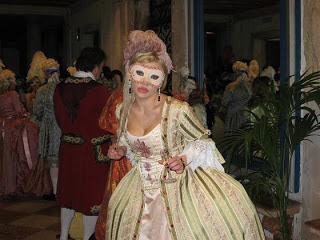 A Venice Canavale Party-Goer in Victorian Costume
A Venice Canavale Party-Goer in Victorian CostumeHello My Friend and Welcome.
We continue our Lenten/Easter posts today by examining Shrove Tuesday. The inaugural post of the series, Quinqaugesima Saunday can be found just after this one. The Monday and Tuesday before Ash Wednesday are known as Shrovetide, from the old English word shrive, meaning to confess. People traditionally went to Confession in the days before Lent as a sort of spiritual house cleaning in preparation for the upcoming penitential season of Lent. A SEASON OF PREPARATIONIn addition to spiritual preparations, Lent also required some actual house cleaning as well. Fats, eggs, and butter were not eaten during Lent, so the Tuesday before Ash Wednesday was the last day to use up those provisions. Making pancakes or waffles used up all three at once. In Merry Old England, we find the rather reserved English letting their hair down by eating pancakes and sausages. This popular custom continues. Today nearly all Anglican churches have a tradition of gathering their members to celebrate a Shrove Tuesday Pancake Supper. In England they also have pancake races in which women wearing a dress, apron, and bonnet, must flip a pancake as they run. This practice dates back to a 15th Century homemaker who heard the bell summoning her to church and, not wanting to be late, rushed out her skillet still in hand.
 A Dutch Baby Fresh out of the Oven with BlueberriesENJOY A DUTCH BABYInstead of the regular Aunt Jemima type pancakes, you might like to try the baked pancake known as a Dutch Baby. Here's a recipe:
A Dutch Baby Fresh out of the Oven with BlueberriesENJOY A DUTCH BABYInstead of the regular Aunt Jemima type pancakes, you might like to try the baked pancake known as a Dutch Baby. Here's a recipe:Ingredients: 1 cup flour, 2 Tbsp sugar, 1 cup milk, 3 eggs, pinch of salt and a pinch of nutmeg.Process: Put an iron skillet in a 425 degree oven and let it heat. Meanwhile, combine the egg and milk and whip until the eggs are dispersed. Add the other ingredients and whisk or beat until smooth. When your skillet is hot, carefully remove from the oven and run a stick of butter around the bottom and sides. Pour in your batter and return to oven for 15 minutes. The edges should be crisp and brown when it comes out. Remove from pan, dust with powdered sugar and top with fruit if desired.
 Jokers Marching in Fasching Parade
Jokers Marching in Fasching ParadeEAT, DRINK, AND BE MERRYSince Lent entailed a period of prolonged fasting, Shrove Tuesday represented the last day for feasting. And, since Lent was a somber, penitential time, it was also the last day for parties. Over time Shrove Tuesday became a time for people to eat, drink, and make merry. Nearly all European cities have Carnevale celebrations with parades, costumes and various localized traditions. The same is true of Central and South America.In France the day came to be called Fat Tuesday, or Mardi Gras. In Poland, the food of the day is Paczki, pronounced punch-key, large, filled and fried doughnuts. They have become so traditional that many Poles refer to Shrove Tuesday Paczki Day.Fasching is the somewhat sedate German version of Carnival. As in other places, it's an opportunity for people to act silly before settling into the serious time of Lent. As part of Fasching, the Thursday before Ash Wednesday is known as Weiberfastnacht, or Women's carnival night. This is the day women are allowed to cut off the tie of any man within reach and kiss any man they like. Faschingsdienstag, or Carnival Tuesday, is the last day of Fasching and when most of the festivities happen. Some of the street parades date as far back as the 14th Century. Fats and eggs make their appearance here in the form of donuts.
 Float in Sambadrome in RioCARNAVAL – PUSHING THE ENVELOPEThe word Carnaval or Carnavale, is derived from the Latin word carnelevare, which refers to the taking away of flesh. The Lenten fast of years ago typically eliminated meat from the diet. Over time what began as a quasi-religious celebration has become a secular holiday. Given time and the human proclivity to overdo, this has resulted in the bacchanalian festivities we have today.Two of the most well-known are the Mardi Gras celebration in New Orleans and the Carnaval in Rio. Being in the Southern Hemisphere, Rio's Carnaval takes place at the peak of summer and attracts thousands of people from around the world. Carnaval, as it is spelled in Portuguese, is a 4-day celebration. It starts on Saturday, and ends on Shrove Tuesday. Despite the notoriety it generates, the Brazilian festival is of somewhat recent origin. Carnaval balls were imported to Rio from Italy in the late nineteenth century, and reached their peak in the 1950's. The Samba Parade began in the 30's and found a permanent home in 1984 at the Sambodrome. Rio's Carnaval is known for its fantastic floats, many of which feature nearly naked women.
Float in Sambadrome in RioCARNAVAL – PUSHING THE ENVELOPEThe word Carnaval or Carnavale, is derived from the Latin word carnelevare, which refers to the taking away of flesh. The Lenten fast of years ago typically eliminated meat from the diet. Over time what began as a quasi-religious celebration has become a secular holiday. Given time and the human proclivity to overdo, this has resulted in the bacchanalian festivities we have today.Two of the most well-known are the Mardi Gras celebration in New Orleans and the Carnaval in Rio. Being in the Southern Hemisphere, Rio's Carnaval takes place at the peak of summer and attracts thousands of people from around the world. Carnaval, as it is spelled in Portuguese, is a 4-day celebration. It starts on Saturday, and ends on Shrove Tuesday. Despite the notoriety it generates, the Brazilian festival is of somewhat recent origin. Carnaval balls were imported to Rio from Italy in the late nineteenth century, and reached their peak in the 1950's. The Samba Parade began in the 30's and found a permanent home in 1984 at the Sambodrome. Rio's Carnaval is known for its fantastic floats, many of which feature nearly naked women.
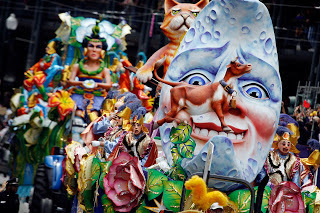 Mardi Gras Float in New OrleansThough most people think of Mardi Gras taking place on Shrove Tuesday, the Celebrations in New Orleans begin two weeks before. Driven primarily by the tourist trade, there is at least one major parade each day leading up to the finale on Tuesday. The parades in New Orleans are organized by Carnival krewes. Krewe float riders toss throws to the crowds; the most common throws are strings of colorful plastic beads, doubloons (aluminum or wooden coins impressed with a krewe logo), decorated plastic throw cups, and small toys. While generally considered a raucous event, the New Orleans Mardi Gras celebrations never approach those in Rio.FROM CHRISTIAN PREPARATION TO PAGAN FEASTSIt seems we have run the gamut from sedate gatherings designed to emphasize the traditions and solemnity of the penitential nature of the Lenten Season to bawdy festivals that are primarily pagan in nature. In thermodynamics the concept of entropy measures the tendency of a process, such as a chemical reaction, to proceed in a direction which reduces its state of order to that of disorder. Does this same rule apply to human activities as well? Can it be said that when human beings are left to their own devices they inevitably descend from goodness to sinfulness? Jesus spoke of the narrow gate and the wide gate and the seed that fell on infertile ground. St. Paul exhorted early Christians to strive for the higher things of life. The way in which Early Church celebrated Shrove Tuesday versus the way it is celebrated in some places now tends to support the notion that high moral character is only achieved by overcoming the entropy of our lower nature.Our next post in the series will deal with the first day of Lent, Ash Wednesday.Until then, we wish Peace and Blessings.If you reached this post via a link, click the HOME tab above to see other posts and our archives.
Mardi Gras Float in New OrleansThough most people think of Mardi Gras taking place on Shrove Tuesday, the Celebrations in New Orleans begin two weeks before. Driven primarily by the tourist trade, there is at least one major parade each day leading up to the finale on Tuesday. The parades in New Orleans are organized by Carnival krewes. Krewe float riders toss throws to the crowds; the most common throws are strings of colorful plastic beads, doubloons (aluminum or wooden coins impressed with a krewe logo), decorated plastic throw cups, and small toys. While generally considered a raucous event, the New Orleans Mardi Gras celebrations never approach those in Rio.FROM CHRISTIAN PREPARATION TO PAGAN FEASTSIt seems we have run the gamut from sedate gatherings designed to emphasize the traditions and solemnity of the penitential nature of the Lenten Season to bawdy festivals that are primarily pagan in nature. In thermodynamics the concept of entropy measures the tendency of a process, such as a chemical reaction, to proceed in a direction which reduces its state of order to that of disorder. Does this same rule apply to human activities as well? Can it be said that when human beings are left to their own devices they inevitably descend from goodness to sinfulness? Jesus spoke of the narrow gate and the wide gate and the seed that fell on infertile ground. St. Paul exhorted early Christians to strive for the higher things of life. The way in which Early Church celebrated Shrove Tuesday versus the way it is celebrated in some places now tends to support the notion that high moral character is only achieved by overcoming the entropy of our lower nature.Our next post in the series will deal with the first day of Lent, Ash Wednesday.Until then, we wish Peace and Blessings.If you reached this post via a link, click the HOME tab above to see other posts and our archives.
Published on February 20, 2012 01:00
February 17, 2012
LOOKING TO EASTER — QUINQUAGESIMA SUNDAY
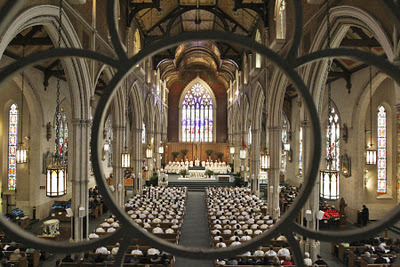 Looking in on Quinquagesima Sunday Mass - Toronto, Canada
Looking in on Quinquagesima Sunday Mass - Toronto, CanadaHello My Friend and Welcome.
As mentioned in the last few posts, we will be doing a series of posts related to Easter and they begin today. However, in the Church's calendar and traditions, the penitential season known as Lent and the glorious season known as Pascha, or Easter, are interrelated. There are also a number of other special days included such as Ash Wednesday, and Holy Week, which includes Maundy Thursday, Good Friday and Holy Saturday. So throughout the upcoming Lenten season we will be scattering posts relating both to Easter and to Lent.
MORE THAN JUST A DAYEaster, like Christmas, is more than just a day; it is a season. The Easter season begins on Easter Sunday and ends fifty days later on Pentecost. Some churches follow the liturgical calendar with its Feasts and Festivals, liturgical colors and so on. Others do not. Either way, we encourage you come along with us whether you do or don't currently follow a liturgical calendar. The roots of many of these traditions can be traced back to the early Church. We have lots of fun facts to share and, whatever faith tradition you adhere to, you'll find the posts both educational and enriching. That said, let's move onto to our first post.
QUINQUAGESIMA SUNDAYIn times past, the Sunday prior to Ash Wednesday (this coming Sunday, February 19, 2012) was often referred to as Quinquagesima Sunday from the Latin for fiftieth. In other words, there are fifty days from this coming Sunday to Easter. Your first thought may have been, "Wait a minute, Lent only lasts forty days. If you start with Sunday and add in the Monday and Tuesday before Ash Wednesday you'll get 43, not 50." This overlooks two things. First, Sundays are not counted as part of Lent. So we need to add in the six Lenten Sundays. Also, Lent ends at midnight on Holy Saturday. Easter Sunday must also be included. The math goes like this: starting with 40, we add 3 (Sun, Mon & Tues) + 6 (Sundays) + 1 (Easter) and get (Ta Da!) 50.
THE NUMBER FORTY IN THE BIBLEAs mentioned above, Lent lasts forty days. The early Church Fathers did not pull this figure out a hat. The number forty appears all through the Bible. And, more often than not, it is associated with a period of waiting, probation, or preparation. The following list is in no way inclusive. It does, however, demonstrate the re-occurrence and importance of the number forty throughout the Bible.
In the Old Testament:It rained for forty days and nights. Likewise, Noah waited 40 days after the waters receded before sending out a raven. (Genesis 8:3-8)
Isaac was 40 years old when he married Rebecca. (Genesis 25:20)
Esau was 40 years old when he married his two wives. (Genesis 26:34)
The Israelites ate Manna 40 years in the Desert. (Exodus 16:35-6)
Moses spent 40 days and nights on Mount Sinai. (Exodus 24:18) He came down, saw the
Golden Calf and broke the tables. Then in Exodus 24:28 he returns and fasts 40 days.
The scouts spied in the Promised Land 40 days before returning. . (Numbers 13:25)
Then the Israelites were required to spend 40 years "wandering" in the Desert. (Numbers 14:33)
Joshua was 40 years old when he spied with the scouts. (Joshua 14:7)
Goliath taunted Israel 40 days before his defeat by David. (1 Samuel 17:16)
King David reigned for 40 years. (2 Samuel 5:4)
King Solomon reigned for 40 years. (1 Kings 11:42)
Elijah fasted 40 days in the wilderness. (1 Kings 19:8)
Jonah preached to Nineveh for 40 days before they repented. (Jonah 3:4)
Ezekiel lay on his right side for 40 days. (Ezekiel 4:4)
In the New Testament we find:The Purification of Mary is 40 days after birth of Jesus (Leviticus 12:1-4, Luke 2: 22-4)
Jesus spent 40 days fasting in the desert after His baptism (Matthew 4:1-2)
Jesus also spent 40 days on earth following His Resurrection (Acts 1:3)
And, Jesus, by tradition, spent 40 hours in the tomb.
The forty days of Lent, as we can see, have deep significance. We will examine this in more detail as we move through our posts over the next six or seven weeks.
THE DANGERS OF A LITTLE BIT OF KNOWLEDGEThis is as good a time as any to deal with the overall concept of Easter. As we found in our study on All Things Christmas, there are many half-truths and misconceptions surrounding the traditions and practices of the Church. People perpetuate these falsehoods either out of ignorance or because it discredits the Church and, by discrediting the Church, they gain credibility.
In the case of Christmas, it was the false fact that Christmas was placed on December 25th because that date corresponded with pagan solstice feasts. We disproved that in our post Why Dose Christmas Come on December 25th? If you missed it, you can find it HERE.
Easter, too, we are told is a pagan holiday. As Easter approaches and you'll hear this refrain repeated over and over. For the sake of charity, we'll assume that the people saying this are simply misinformed.
REFUTTING THE MYTH OF PAGAN OEIGINS First of all, while we cannot be certain when Jesus of Nazareth was born, we know with certainty when he died. As we said earlier, Easter is known as The Pascha everywhere except in the English speaking world. Pascha is Greek for Passover…the day on which Jesus was crucified. But didn't pagans have Spring festivals? Of course they did. Many small towns have a Fall Harvest Festival…an Apple Fest, a Pumpkin Show, etc. Are these festivals a ritualistic way of paying homage to the Earth Goddess, or simply an opportunity for family fun and food from traveling food booths?
So where did the connection of Easter and paganism come from? It began with the observations of an 8th Century Christian writer. Again, like the Christmas speculation, a passing comment took on a life of its own. In this case, the Venerable Bede said that the word Easter was derived from the name of the pagan goddess Eostre, whose name was in turn derived from the Norse word for Spring, Eastre. So Easter comes from Spring, which seems appropriate. Note, he was talking about the word Easter, not the Easter beliefs and practices.
 Boiled Eggs Dyed Red
Boiled Eggs Dyed RedTRADITIONAL EARLY CHRISTIAN EASTER PRACTICESBut what about those practices? Those boiled eggs in a basket of grass, etc? Let's take a closer look. Circadian rhythms are biological processes that are dependent upon day length. Modern egg producers stimulate a hen's laying cycle by extending the perceived day length with artificial light. People living in the First Century didn't have this luxury; they had to depend upon the natural cycle of solstices and equinoxes. Consequently, as the days grew longer with the coming of Spring, their hens were stimulated to begin laying. Also, during the 40-day period of fasting preceding Easter, the Early Christians did without meats, fats and eggs.
What could be more opportune? Just as we move into Spring and the celebration of the Resurrection, the hens begin to produce eggs again. Eggs, of course, are ideal representations of a resurrection of sorts when they hatch and of the new life the Christians found in Christ. Interestingly, the Early Christians dyed boiled eggs red —for the saving blood of Jesus Christ. They presented them to their children on Easter morning as a reminder of the Paschal mystery of Christ's death and resurrection. Easter morning, of course, was also the first day that eggs could be eaten again. This year when you boil and color eggs with your children or grandchildren, tell them the story of the Early Christians. Remind them that, like those children of the early centuries, they are participating in a holy tradition. Be sure to also remind them that those children never had chocolate.
Next time we will focus on Shrove Tuesday, the origin of Mardi Gras.
Until then, we wish you Peace and Blessings.
If you reached this post via a link, click the HOME tab above to see other posts and our archives.
Published on February 17, 2012 01:00
February 15, 2012
CHRISTIAN WRITER'S BLOG CHAIN — LEAP
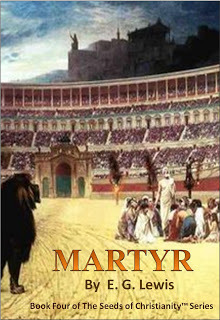
Hello My Friend and Welcome.
Today's post is our contribution to the Christian Writer's Blog Chain. The topic this month is leap and, as usual, I'll address it from an authorial perspective. This year is a leap year meaning February is a day longer.
[Memo to Writers: You have an additional day for writing this year. Do not waste it!]
When I hear leap, the phrase that most often comes to mind is a leap of faith. We could interpret it literally and recall the time or times we've relied upon the strength of our religious convictions to see us through. However, seen in a more general way it simply means trusting our inner voice, to go with our gut feelings.
Last month I spoke about my current WIP, MARTYR and giving Yudah a great girl to marry. Happily, it is now a completed project…though I missed my deadline by about a week. (Cutting 10,000 words can do that.)
To meet his future wife, Rhebekka, Yudah had to make a huge leap of faith. I've including a condensed excerpt from the five-chapter subplot in which Yudah, finds his bride. The overarching story takes the family Antioch to Rome where Rivkah and her husband, Shemu'el assist Simon Peter. Along the way their ship stops on the island of Cyprus. Paphos, on the western end of the island, was home to the famous Temple of Aphrodite where young women participated in rites of prostitution to prepare them for marriage.
With nothing else do to while the ship is docked, Yudah decides to go into town and see the sights. He passes the Temple just as the parade of initiates begins and notices a young woman who looks terribly out of place. The only way he can solve the riddle of her unhappiness is to enter the Temple and select her. Making a leap of faith, he heads up the Temple steps. They end up spending the night together, though he doesn't sleep with her. By morning they've shared their life stories and decided to marry.
We'll start with the last paragraphs of Chapter Seven called, appropriately enough, Yudah and Rhebekka.
~ 7 ~
"When love beckons to you, follow…"
—Kahlil Gibran, The Prophet
Yudah dashed up the stairs two at a time and took a position near the last pillar. It put him far from the conical rock, the place of choosing, and at the very end of the evening's suitors. The other men shoved and jostled for a place near the head of the line. Everyone, it seemed, wanted to be first. Everyone, that was, except Yudah. He paid little attention to the undulating row of young women who passed him chanting, dancing, and waving their feathered drums as seductively as possible. After a long wait, the woman he'd watched from the street appeared, as downcast as before. He fell into step beside her.
She shot him an angry glance. "What do you want?"
He chuckled. "I thought everyone knew. Did they forget to tell you?"
"Your jokes are not appreciated. I see plenty of available women, most of them more attractive than me. Why not choose one of them?"
"I may select the woman of my choosing, and I chose you."
"What if I do not want you?"
"As I understand it, the choice is mine to make."
They reached the conical rock, the place for choosing, and the young woman attempted to continue on without stopping.
The matron supervising the evening's activities caught her by the arm and yanked her back. "You failed to stop at the place of selection child. You must take your place on the square tile in front of the conical stone and proudly declare, 'I bring a love offering to Aphrodite. Who will have me?'"
The young woman's shoulders slumped. Head down, she took her place on the tile and mumbled the phrase.
Yudah immediately stepped forward and threw a denarius at her feet.
The two of them stood like statues, neither knowing what to do next and afraid to look each other in the eye.
The matron stormed over. "What is wrong with you? This is a joyful moment and you act like you are going to your execution. Pick up your money, take the man's hand, and lead him to your cubicle so you may consummate the blessing he has invoked."
She pressed the low-cut neckline of the gown to her body and bent to retrieve the coin. Rising, she took Yudah's hand and started down the hall.
"Wait!" The matron rolled her eyes. "Why must I always get the stupid ones? Did you learn nothing this afternoon? You must say the formulaic phrases to receive the goddess' blessing."
The young woman sighed.
Yudah squeezed her hand, offering encouragement.
She drew a deep breath. "Uh, come with me to…to my chamber where we will …umm, share Aphrodite's…whatever."
"That is close enough." The matron waved her hands shooing them away. "Go. I have work to do."
(Skipping ahead)
Rhebekka smiled for the first time. "Have you ever heard of a man named Yosef who is called Barnabus?"Yudah grinned. "What an interesting world this is. I know Barnabus well. He lodged at my father's house each time he came to Antioch."
"Barnabus is the one who instructed me in the way of the Lord."
He took her hand in his. "I must ask what a Christian girl is doing in the Temple of Aphrodite."
"Should I not ask the same of you? Why is a good Christian man intent on deflowering a virgin?"
"Ah yes, at first glance that does seem problematic." He cupped his chin. "Perhaps this will make things clearer. As a youngster my mother sometimes assigned miscellaneous household chores to my sister and I while she went to market. On occasions, when we did not wish to complete a particular task, my sister and I agreed not to do it and say we did. I suggest we make a similar pact here and now…let's not and say we did."
Tears welled in her eyes. "This makes no sense. What are you up to?"
"No sense, you say?" He picked up her drum with its rim strung with feathers and its stretched skin top decorated with symbols of fertility. He studied it carefully, moving it this way and that. "I see only bent wood, feathers, and a piece of animal skin here. Where is the music?" He turned it over and stared into its hollow back. "I find no music."
Yudah took Rhebekka's face in his hands and stared deep into her eyes. "The music is not in the instrument. The music lies in the musician's heart and soul, your heart and soul. Should I wish to possess the music, it is you I must have not your silly drum."
He moved onto the bed beside her and slipped his arm around her.
She tilted her head onto his shoulder.
"Let's spend this night learning about each other," Yudah said.
~ 8 ~Yudah and Rhebekka snuggled close. Talked out, they were content to hold each other in the darkness. From far off a cock's crow sounded. They jerked apart and gasped. With one voice they said, "It is nearly dawn."
Yudah leaped up. "I must go."
He held Rhebekka tightly and kissed her good-bye before leaving the small cubicle. Hanging lamps along the walls cast semi-circles of light on the dark floor. His footsteps echoed off the marble walls as he hurried down the silent corridor to the pavilion where burned out fire pots from the previous night's ceremonies emitted an earthy smell.
Yudah slid his hand along the ornate railing as he descended the marble staircase. The eastern sky showed streaks of red. The far off bark of a dog intruded on the early morning solitude. Gone were the crowds, excitement, and noise of the previous evening. Its passions sated for another day, the city slumbered.
He paused momentarily, getting his bearings then darted down the street. A row of Tamarisk trees bordered the Temple. They kept them trimmed high to provide shade for its open porticos on hot afternoons. The trees were in full bloom and even in the pre-dawn darkness Yudah could see lacy tufts of pink flowers sprouting from the tips of each branch. Discarded petals pooled in wide circles around the base of each tree.
He glanced left and right then slipped behind the first tree, crunching dry petals beneath his feet. Yudah leaned against the deeply furrowed bark and cast watchful glances at the main stairway. His worries increased with each passing second. He wanted to believe Rhebekka would keep her word…that she'd come to meet him as they'd agreed. What if she didn't?
The Temple complex had many entrances and exits. If she chose to, Rhebekka could exit from the other side of the building and slip away unseen. He would be left waiting, never to see her again. Yudah remembered her sitting on the bed, her shoulders quivering as she wept and hated himself for entertaining such notions.
* * *As soon as Yudah left, Rhebekka hurried down the hall to the niche where she'd deposited her clothing the previous day. She removed the simple homespun tunic, cloak and scarf along with her sandals, purse and loincloth. She surveyed the other cubbyholes. All empty; everyone else had left. The only sound was the slap of her bare feet on the polished marble floor as she jogged back to her small cubicle. She passed a fountain and paused to wash her face. The cool water felt refreshing on cheeks left hot by many tears.
Returning to her room, she quickly stripped off the transparent gown of Aphrodite and pulled on her own tunic and cloak. She looped a plain girdle made of woven rope around her waist, knotted it, and slipped her feet into her sandals.
Rhebekka reached into the simple cloth bag she'd brought with her and extracted an ivory comb. She quietly hummed to herself as she ran it through her hair. Once the tangles were out, she combed it straight back and gathered her tresses. Placing a polished stick between her teeth, she laid a piece of tooled leather over the hank of hair and secured it with the stick. She feathered her bangs and smiled. She felt like herself again instead of a harlot. She applied a modest amount of color to her cheeks and lips and then threw a scarf over her head.
She refolded the filmy garment the matron provided each initiate, placed her drum on it, and double-checked to make certain she wasn't leaving anything behind. Lastly, she removed the bed cloth. After carefully folding it, she placed it on top and carried the stack to the matron.
The woman answered her knock in a robe, rubbing her eyes. "I had given up hope of you ever coming by." She yawned. "The others left hours ago."
"Well, here I am," Rhebekka said with a happy grin.
"You look much different than when you arrived. You seem happier, fulfilled." The woman winked. "Perhaps, even satisfied? See, is it not just as I told you? Aphrodite blesses even the most reluctant initiate."
Rhebekka offered her the garments. "I have indeed been blessed."
The matron took the garments Rhebekka thrust at her. "Is there something you wish to share about your evening spent serving the goddess?"
Rhebekka masked her fears with a smile. "Oh no, that won't be necessary. As you said, I was reluctant at first. But as time went on, I found an unexpected exhilaration. I shall always remember it as a most enjoyable night."
The matron shrugged, gave the stack of clothing a perfunctory once over, and signaled her approval.
Rhebekka turned and left without a backward glance.
* * *Yudah's heart leapt when he heard the sound of footsteps scurrying across the portico. From the shadows he watched Rhebekka descend the stairway and turn onto the street. She looked both ways and, seeing no one, headed directly for the tree where he waited.
Yudah looked her up and down, noting the change in her appearance. "Do I know you?"
Rhebekka giggled and gave him a quick kiss. "Not as well as you are going to."
He held her close. "I feared you might not come."
She leaned into him. "And I worried you would not be here."
"But you did and I was." Yudah hugged her tightly and gave her a long, lingering kiss.
Breathless when he released her, she glanced back over her shoulder. "There is no one on the portico, but even if there were they could not see us. It is safe for us to leave together," she whispered.
Stepping out of the darkness, Yudah took her hand. Their fingers entwined as they walked to the docks.
On Friday we'll begin our series of posts on Traditions Lent and Easter beginning with Quinqagesima Sunday.
Until then, we wish you Peace and Blessings.
If you reached this post via a link, click the HOME tab above to see other recent posts and visit our archives.
Published on February 15, 2012 01:00
February 13, 2012
THE FEAST DAY OF ST. VALENTINE – FEB. 14th
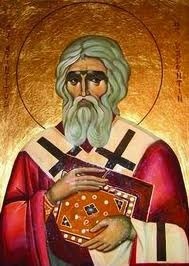 Ikon of St. Valentine
Ikon of St. ValentineNote Red Garb of a Bishop Similar to St. Nicholas Hello My Friend and Welcome.
Tomorrow, February 14th, is Valentine's Day… or more properly the Feast Day of St. Valentine. By the way, when we were growing up my friends and I still referred to it as SAINT Valentine's Day. It seems that secular materialism has overtaken all of the historic religious celebrations. Consider this list, Valentine's Day, Shrove Tuesday (Mardi Gras), St. Patrick's Day, Easter, Halloween — once called All Hallows' Eve, Thanksgiving and, of course, the King of commercialism, Christmas. The religious origins and deeper meaning of each of these days has been lost in the race to sell cards, candy, and related bric-a-brac. But I digress.
VERY LITTLE KNOWNIn truth, very little is known about St. Valentine. He is described as a presbyter (priest) who was martyred in Rome and buried on February, 14th on the Via Flaminia north of Rome. The name, in Latin, Valentinus, is derived from the root word valens meaning worthy, strong, or powerful. Interestingly enough, the name Valentinus does not occur in the earliest lists of Roman martyrs.
The origin of St. Valentine and how exactly many St. Valentines there were, remains a mystery. One opinion is that he was a Roman martyred for refusing to give up his Christian faith. Other historians hold that St. Valentine was a priest jailed for defiance during the reign of Claudius. Whoever he was, Valentine really existed because archaeologists have unearthed a Roman catacomb and an ancient church dedicated to Saint Valentine. In the year 496 Pope Gelasius marked February 14th as a celebration in honor of his martyrdom, saying Valentine was among those "... whose names are justly reverenced among men, but whose acts are known only to God."
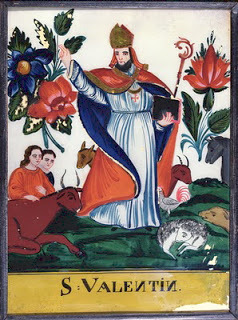 Antique Illumination of St. Valentine
Antique Illumination of St. ValentineWILL THE REAL ST. VALENTINE PLEASE STAND UPThe Catholic Church's official list of recognized saints, the Roman Martyrology, lists seven Valentines: a martyr (possible a Roman priest or Terni bishop) buried on the Via Flaminia (February 14); a priest from Viterbo (November 3); a bishop from Raetia who died in about 450 (January 7); a fifth-century priest and hermit (July 4); a Spanish hermit who died in about 715 (October 25); Valentine Berrio Ochoa, martyred in 1861 (November 24); and Valentine Jaunzarás Gómez, martyred in 1936 (September 18). Valentine did not appear in the official Church calendar for centuries, however "Martyr Valentinus the Presbyter and those with him at Rome" remains on the list of saints proposed for veneration by Catholics. In the Eastern Orthodox Church, Saint Valentine the Presbyter is celebrated on July 6, and Hieromartyr Saint Valentine (Bishop of Interamna, Terni in Italy) is celebrated on July 30. Clearly they are viewed as two separate people. Notwithstanding that, conventionally members of the Greek Orthodox Church named Valentinos (male) or Valentina (female) celebrate their name on February 14th.
The Nuremburg Chronicle states that Valentine was a Roman priest martyred during the reign of Claudius II, known as Claudius Gothicus. He was arrested and imprisoned when caught marrying Christian couples and otherwise aiding persecuted Christians. Claudius took a liking to this prisoner, at least until Valentinus tried to convert the Emperor. Then the priest was condemned to death.
FROM YOUR VALENTINEThe Golden Legend, or Legenda Aurea of Jacobus de Voragine, compiled about 1260 and one of the most-read books of the High Middle Ages, gives sufficient details of the saints for each day of the liturgical year to inspire a homily for the occasion. The very brief details of St. Valentine have him refusing to deny Christ before the Emperor Claudius in the year 280. One legend says, while awaiting his execution, Valentinus restored the sight of his jailer's blind daughter. A further legend says that on the eve of his death he penned a farewell note to the daughter, signing it, "From your Valentine."
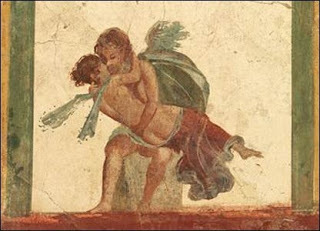 Pompeii Frescoe of Adult Cupid with PhyscheWHAT'S LOVE GOT TO DO WITH IT?
Pompeii Frescoe of Adult Cupid with PhyscheWHAT'S LOVE GOT TO DO WITH IT?Most of the romantic lore surrounding Saint Valentine was invented in 14th Century England by Geoffrey Chaucer. In Chaucer's Parliament of Foules there is a fictional reference to old traditions, although no such tradition existed before Chaucer. These sentimental customs posing as historic fact, appeared in the 18th Century Butler's Lives of Saints, and have been perpetuated by scholars ever since. In a 14th Century French manuscript, Saint Valentine, the Bishop of Terni, oversees the construction of a basilica. There is no suggestion that the bishop was a patron of lovers.
Valentine greetings have a long history. The oldest known valentine still in existence was a poem written in 1415 by Charles, Duke of Orleans, to his wife while he was imprisoned in the Tower of London following his capture at the Battle of Agincourt. Several years later, it is believed that King Henry V hired a writer named John Lydgate to compose a valentine note to Catherine of Valois.
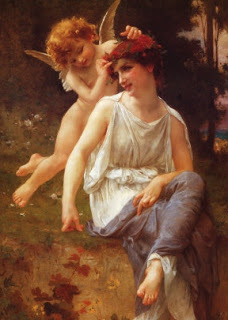 Cupid's Transition from Adult to Baby Begins In Great Britain, Valentine's Day became an official holy day under Henry VIII and began to be popularly celebrated around the 17th Century. By the middle of the 18th Century, it had become common for friends and lovers of all social classes to exchange small tokens of affection or handwritten notes. By 1900 printed cards began to replace written letters.
Cupid's Transition from Adult to Baby Begins In Great Britain, Valentine's Day became an official holy day under Henry VIII and began to be popularly celebrated around the 17th Century. By the middle of the 18th Century, it had become common for friends and lovers of all social classes to exchange small tokens of affection or handwritten notes. By 1900 printed cards began to replace written letters.
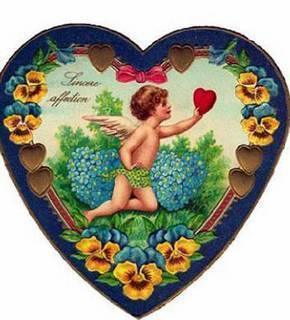
Americans also probably began exchanging hand-made valentines in the early 1700s. In the 1840s, Esther A. Howland began selling the first mass-produced valentines in America. Howland, known as the "Mother of the Valentine," made elaborate creations with real lace, ribbons and colorful pictures. The Greeting Card Association says an estimated 1 billion Valentine's Day cards are sent each year, making Valentine's Day the second largest card-sending holiday of the year.
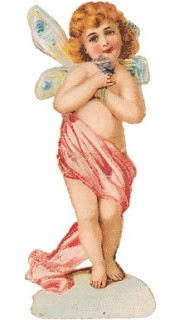 A Victorian Image of Cupid
A Victorian Image of CupidSTUPID CUPID Somewhere along the line the cherubic Cupid entered the scene. Ask most people about Cupid and they're apt to describe a cute, chubby cherub with wings and a bow. Cupid is, of course, a Roman God adapted from the Greek, Eros. In both cases they are winged entities and usually represented carrying a bow and arrows with which they inflict the sting of love. However, they were always depicted as virile young men rather than plump little babies. How and why this pagan God invaded the celebration of St. Valentine's Feast Day is unclear. What is clear that this cutesy character first appeared in Victorian times and, like Santa Claus, found a place in the collective imagination.
Looking ahead, on Wednesday we'll have our monthly post in the Christian Writer's Chain. On Friday we temporarily set aside other interests in order to concentrate on The Ancient Traditions and History of Lent and Easter. Our first post in this special series will deal with what was historically called Quinqagesima Sunday…the last Sunday in the Church calendar prior to Ash Wednesday and the start of Lent. Until then, we wish you Peace and Blessings. If you reached this post via a link, click the HOME tab above to see other recent posts and visit our archives.
Published on February 13, 2012 01:00
February 9, 2012
SILVER - THE QUEEN OF METALS
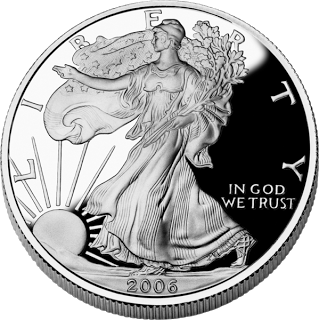 Arguably One of the Most Beautiful Coins ever Minted Hello My Friend and Welcome. Today we continue our study of ancient metals when we take a look at silver. If you missed our first post in this series on Gold, The King of Metals, you can find it HERE. The second in this series on Copper is HERE. PUTTING THINGS IN PERSPECTIVETo put ancient metallurgy into perspective, consider the following facts. There are currently 86 known metals. These include a number of trans-uranium elements such as Neptunium, Plutonium, Einsteinium, and others created in particle accelerators, popularly known as atom smashers. Prior to the 19th Century, only 24 of these 86 metals had been discovered and half of those were added in the 18th Century. Five of those remaining 12 date to the 16th or 17th Century. Thus, ancient civilizations survived with only seven metals. These posts, by the way, are following the chronology of their discovery. Gold was first, Copper second, and Silver is considered to be the third metal discovered by man. Unlike gold and copper which occur naturally in their pure form, silver in its native form very rarely appears as nuggets. Most often, silver is found in combination with copper, nickel, gold, lead, zinc and sulfur. Mankind's use of silver represented a great leap forward in ancient metallurgy. For the first time, men began gathering ore rather than nuggets, refining and separating silver from its companion elements.
Arguably One of the Most Beautiful Coins ever Minted Hello My Friend and Welcome. Today we continue our study of ancient metals when we take a look at silver. If you missed our first post in this series on Gold, The King of Metals, you can find it HERE. The second in this series on Copper is HERE. PUTTING THINGS IN PERSPECTIVETo put ancient metallurgy into perspective, consider the following facts. There are currently 86 known metals. These include a number of trans-uranium elements such as Neptunium, Plutonium, Einsteinium, and others created in particle accelerators, popularly known as atom smashers. Prior to the 19th Century, only 24 of these 86 metals had been discovered and half of those were added in the 18th Century. Five of those remaining 12 date to the 16th or 17th Century. Thus, ancient civilizations survived with only seven metals. These posts, by the way, are following the chronology of their discovery. Gold was first, Copper second, and Silver is considered to be the third metal discovered by man. Unlike gold and copper which occur naturally in their pure form, silver in its native form very rarely appears as nuggets. Most often, silver is found in combination with copper, nickel, gold, lead, zinc and sulfur. Mankind's use of silver represented a great leap forward in ancient metallurgy. For the first time, men began gathering ore rather than nuggets, refining and separating silver from its companion elements.AN ANCIENT METAL Silver has been known since very ancient times. Slag heaps have been found in Asia Minor and on the Aegean islands, indicating that silver was being separated from lead as early as 4,000 BC. The silver mines at Laurium fueled the economy of Ancient Athens. It involved mining the ore in underground galleries, washing the ore and smelting it to extract the metal. Elaborate washing tables still exist at the site that utilized rainwater collected during the winter months in cisterns. By the First Century AD extraction of silver from lead ore was widespread in Roman Britannia.
SILVER IN THE BIBLE The first mention of silver in the Bible occurs in Genesis 13:2, "Abram had become very wealthy in livestock and in silver and gold." It continues to appear in nearly all of the following books. Interestingly, in 1 Kings 10:27 the writers emphasize Solomon's wealth by saying, "The king made silver as common in Jerusalem as stones, and cedar as plentiful as sycamore-fig trees in the foothills." The most famous reference to silver is the New Testament mention of Judas and the thirty pieces of silver he was paid to betray Jesus. Thirty pieces of silver, by the way, was the standard price of a slave at that time. Silver's final appearance occurs in Revelation 18:11-12, "The merchants of the earth will weep and mourn over her because no one buys their cargoes anymore—cargoes of gold, silver, precious stones and pearls…"
 Silver IngotsSilver, like gold and copper, was frequently monetized. Most every nation and empire had, or has, silver coinage. Silver is second only to gold in its ductility and malleability, meaning it is easily pounded, stamped, shaped, bent and drawn out. Polished silver has the highest optical reflectivity of any metal and was used in the ancient world to make mirrors for the wealthy. The lower classes had to make do with polished copper or brass which gave rise to St. Paul's famous quote, "For now we see in a mirror dimly, but then face to face." 1 Cor. 13.12.
Silver IngotsSilver, like gold and copper, was frequently monetized. Most every nation and empire had, or has, silver coinage. Silver is second only to gold in its ductility and malleability, meaning it is easily pounded, stamped, shaped, bent and drawn out. Polished silver has the highest optical reflectivity of any metal and was used in the ancient world to make mirrors for the wealthy. The lower classes had to make do with polished copper or brass which gave rise to St. Paul's famous quote, "For now we see in a mirror dimly, but then face to face." 1 Cor. 13.12. SILVER IN JEWELRYSilver jewelry, often set with gemstones, has been worn for personal adornment by people of all cultures since ancient times. Glass and stone beads were often strung on silver wire to make necklaces, bracelets and anklets. Silver was also made into rings and earrings. Decorative objects made of silver castings were popular in higher class homes in that era.
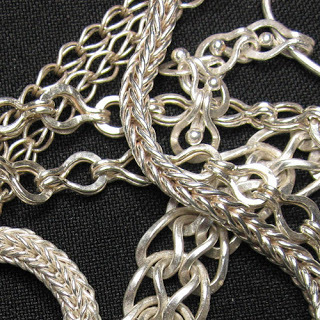 Roman Linked Chains of Silver By necessity, Early Christians were discreet about their faith in order to survive. However, in 303 the emperors Constantine I and Licinius signed the Edict of Tolerance, which resulted in a flowering of Christian art and artistry. It is difficult, if not impossible, to know what it would have meant to these early believers to suddenly be allowed to openly wear an emblem of their faith. Many objects in antiquity, both everyday items as well as those for holy rituals, abounded in Christian imagery. Besides the cross, Christians used the Chi-Rho symbol, an Alpha and Omega, the fish, angels, a starburst and abbreviated inscriptions in Greek which translated to "In Christ, Victory" or "Jesus Christ, King of Kings."
Roman Linked Chains of Silver By necessity, Early Christians were discreet about their faith in order to survive. However, in 303 the emperors Constantine I and Licinius signed the Edict of Tolerance, which resulted in a flowering of Christian art and artistry. It is difficult, if not impossible, to know what it would have meant to these early believers to suddenly be allowed to openly wear an emblem of their faith. Many objects in antiquity, both everyday items as well as those for holy rituals, abounded in Christian imagery. Besides the cross, Christians used the Chi-Rho symbol, an Alpha and Omega, the fish, angels, a starburst and abbreviated inscriptions in Greek which translated to "In Christ, Victory" or "Jesus Christ, King of Kings."
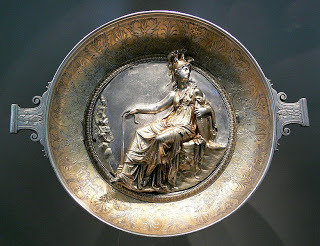 Silver Dish Honoring the Roman Goddess Minerva EARLY CHRISTIAN JEWELRYMany Christian believers wore a cross. Christian jewelry reflected the humility Christ preached. Much of the Christian jewelry in antiquity was simple in design. Stunning bejeweled adornments were avoided. Many of the Byzantine coins of that era had religious inscriptions and images of Jesus or Mary. These coins are sometimes found with holes punched through them so they could be worn as a pendant by an early believer.
Silver Dish Honoring the Roman Goddess Minerva EARLY CHRISTIAN JEWELRYMany Christian believers wore a cross. Christian jewelry reflected the humility Christ preached. Much of the Christian jewelry in antiquity was simple in design. Stunning bejeweled adornments were avoided. Many of the Byzantine coins of that era had religious inscriptions and images of Jesus or Mary. These coins are sometimes found with holes punched through them so they could be worn as a pendant by an early believer.
 Ring found in Kourion with Chi-Rho Archeologists began studying the site of the ancient city of Kourion on the island of Cyprus in the 1980s. The entire town was destroyed on July 21, 365AD when a massive earthquake, with its epicenter near Crete, hit the eastern Mediterranean. Thousands of people vanished beneath tons of stone when the town's buildings collapsed. The exact death-toll from this disaster will never be known. However, in a poignant display of familial love, researchers found an ancient ring with both the Chi-Rho and the Alpha-Omega symbols on the skeletal finger of a young father who had thrown himself over his family to try to protect them as their home collapsed. Next Monday we'll take a look at St. Valentine whose feast day, as you know, the 14th of February. Until then, we wish you Peace and Blessings. If you reached this post via a link, click the HOME tab above to see other posts and our archives.
Ring found in Kourion with Chi-Rho Archeologists began studying the site of the ancient city of Kourion on the island of Cyprus in the 1980s. The entire town was destroyed on July 21, 365AD when a massive earthquake, with its epicenter near Crete, hit the eastern Mediterranean. Thousands of people vanished beneath tons of stone when the town's buildings collapsed. The exact death-toll from this disaster will never be known. However, in a poignant display of familial love, researchers found an ancient ring with both the Chi-Rho and the Alpha-Omega symbols on the skeletal finger of a young father who had thrown himself over his family to try to protect them as their home collapsed. Next Monday we'll take a look at St. Valentine whose feast day, as you know, the 14th of February. Until then, we wish you Peace and Blessings. If you reached this post via a link, click the HOME tab above to see other posts and our archives.
Published on February 09, 2012 01:00



